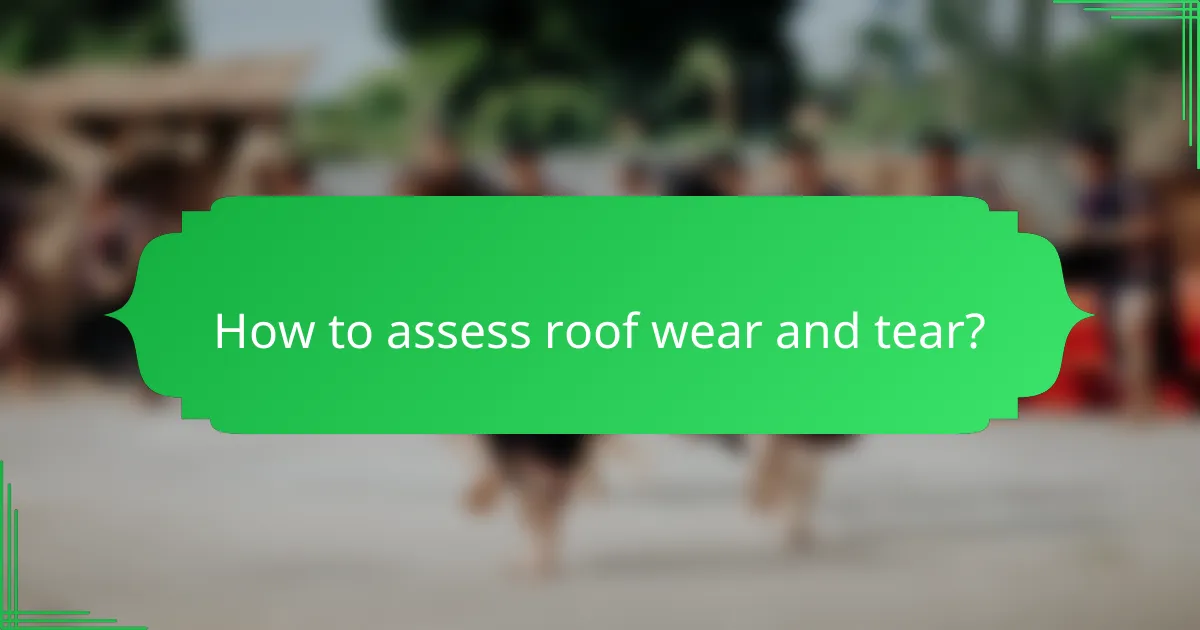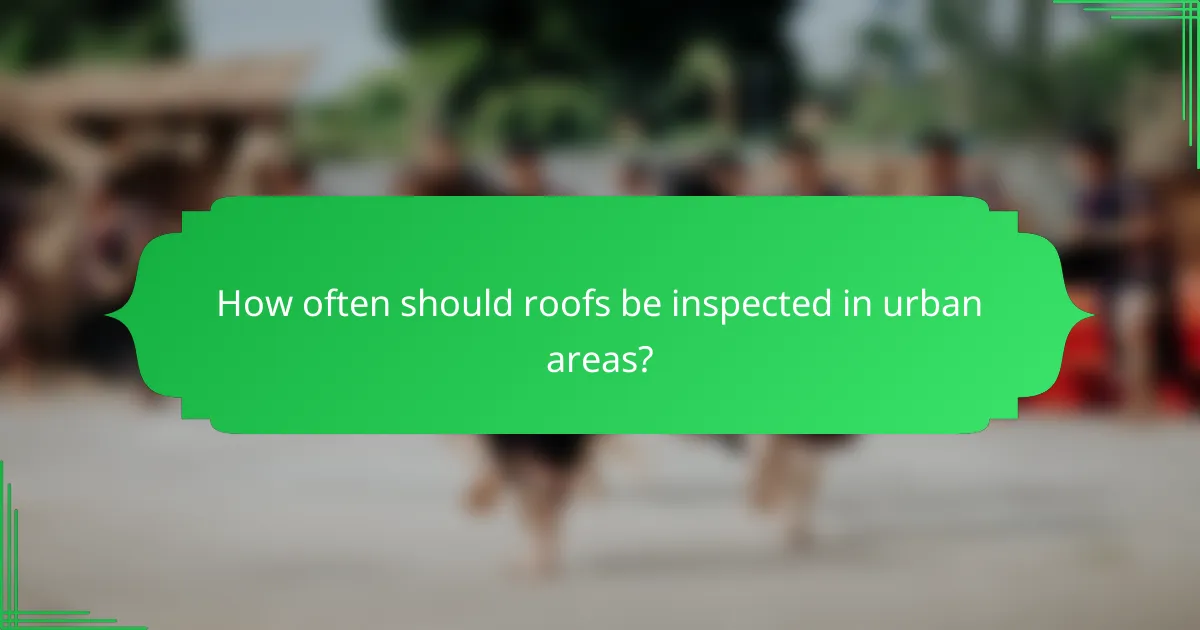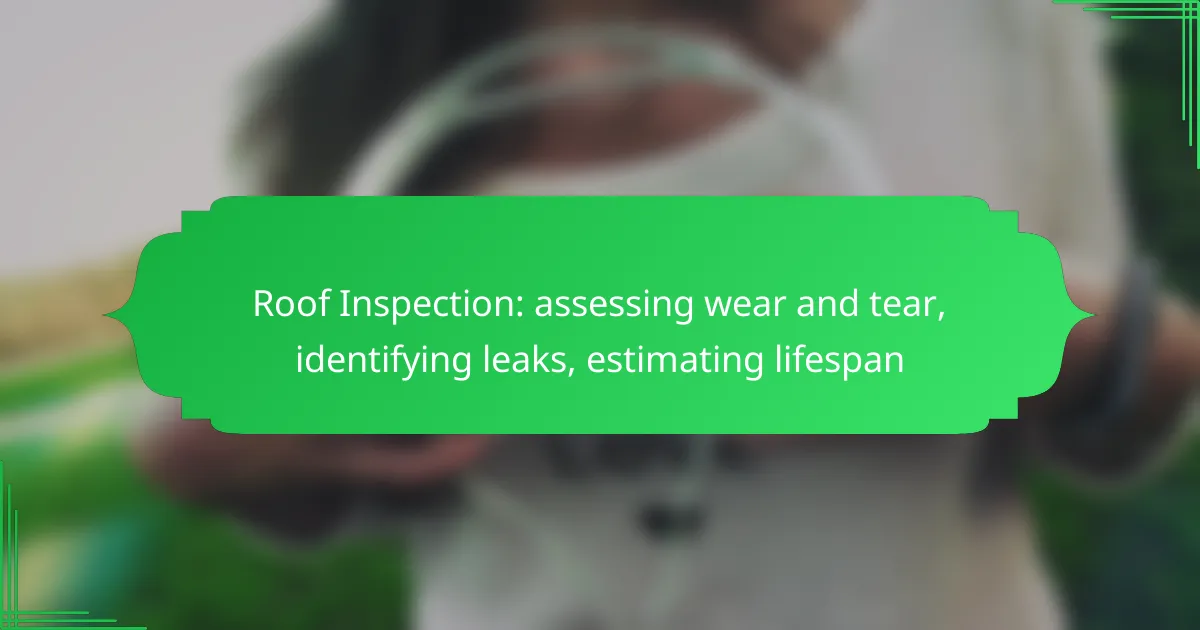Roof inspection is a crucial process that involves assessing wear and tear, identifying potential leaks, and estimating the overall lifespan of the roofing system. By conducting regular inspections, homeowners can detect issues early, ensuring timely repairs and extending the roof’s longevity. Utilizing both advanced technologies and traditional techniques, inspectors can effectively pinpoint leaks and evaluate the condition of roofing materials.

How to assess roof wear and tear?
Assessing roof wear and tear involves a thorough examination to identify any signs of damage or deterioration. Regular inspections can help homeowners catch issues early, prolonging the lifespan of the roof and preventing costly repairs.
Visual inspection techniques
Visual inspection techniques include checking the roof from the ground and using binoculars for a closer look. It’s essential to examine all roof areas, including valleys, ridges, and flashing, for any irregularities. For a more detailed view, consider using a drone or climbing onto the roof if it’s safe to do so.
Look for areas where shingles are missing, curled, or cracked. Pay attention to the condition of gutters and downspouts, as blockages can indicate underlying roof issues. Always inspect after severe weather events, as they can accelerate wear and tear.
Common signs of damage
Common signs of roof damage include leaks, water stains on ceilings, and mold growth in the attic. Additionally, granule loss from shingles can indicate aging, while sagging areas may suggest structural issues. If you notice any of these signs, further investigation is necessary.
Other indicators include rust on metal roofs, blistering or peeling paint, and excessive debris accumulation. Regularly checking these signs can help you address problems before they escalate into more significant repairs.
Tools for assessment
Essential tools for roof assessment include a sturdy ladder, flashlight, and moisture meter. A moisture meter can help detect hidden leaks by measuring moisture levels in roofing materials. A digital camera is also useful for documenting any damage for future reference or when consulting with professionals.
For more comprehensive inspections, consider investing in a thermal imaging camera, which can identify temperature differences that indicate leaks. Always prioritize safety by using appropriate gear and ensuring stable footing when inspecting the roof.

What are the best methods for identifying leaks?
The best methods for identifying leaks in roofing systems include advanced technologies and traditional techniques that help detect moisture intrusion. These methods can pinpoint leaks effectively, allowing for timely repairs and maintenance.
Infrared thermography
Infrared thermography uses thermal imaging cameras to detect temperature variations on the roof surface, indicating potential leaks. This non-invasive method can quickly reveal areas where moisture has infiltrated, as wet materials retain heat differently than dry ones.
When using infrared thermography, it is essential to conduct inspections during specific conditions, such as early morning or late afternoon, to minimize interference from solar heating. Regular inspections can help identify developing issues before they escalate.
Moisture meters
Moisture meters are handheld devices that measure the moisture content in roofing materials. They can be used to assess the extent of water damage and help determine whether a leak is present. There are two main types: pin-type meters, which require direct contact, and non-invasive meters, which can measure moisture through the surface.
For effective use, choose a moisture meter suitable for the materials in your roof system. Regularly calibrating the device ensures accurate readings, and comparing moisture levels across different areas can help identify problem spots.
Water testing procedures
Water testing procedures involve simulating rain on the roof to identify leaks. This method can be particularly useful for flat roofs, where water pooling may indicate underlying issues. Technicians typically use hoses to direct water at specific areas while monitoring for leaks inside the building.
When conducting water tests, it is crucial to document the areas tested and any observed leaks. This method can help pinpoint the source of the problem and guide necessary repairs. Always ensure that local regulations regarding water testing are followed to avoid potential issues.

How to estimate roof lifespan?
Estimating roof lifespan involves assessing the roof’s materials, installation quality, and environmental factors. Generally, roofs can last anywhere from 15 to 50 years, depending on these variables.
Factors affecting lifespan
Several factors influence a roof’s lifespan, including climate, installation quality, and maintenance practices. For instance, roofs in areas with extreme weather conditions may deteriorate faster than those in milder climates.
Additionally, the slope of the roof and the presence of overhanging trees can contribute to wear and tear. Regular inspections can help identify issues early, potentially extending the roof’s life.
Material comparison
Different roofing materials have varying lifespans. Asphalt shingles typically last 15 to 30 years, while metal roofs can last 40 to 70 years. Slate and tile roofs are among the most durable, often exceeding 50 years.
When selecting materials, consider not only lifespan but also cost and maintenance requirements. For example, while metal roofs may have a higher upfront cost, their longevity can make them more economical over time.
Maintenance impact
Regular maintenance significantly affects a roof’s lifespan. Simple tasks like cleaning gutters, removing debris, and checking for leaks can prevent major issues and extend the roof’s life by several years.
Homeowners should schedule professional inspections at least once a year, especially after severe weather. Neglecting maintenance can lead to costly repairs and a reduced lifespan, so proactive care is essential.

What are the costs associated with roof inspections?
The costs associated with roof inspections can vary significantly based on factors like location, roof size, and inspection complexity. Generally, homeowners should expect to pay for both the inspection itself and any subsequent repairs that may be necessary.
Average inspection fees
Average inspection fees typically range from $100 to $500, depending on the roof’s size and the inspector’s experience. In urban areas, costs may lean towards the higher end of this range due to increased demand and living expenses.
Some inspectors may offer free inspections as part of a repair service, but it’s essential to verify their qualifications and the thoroughness of their assessment.
Cost of repairs
The cost of repairs following an inspection can vary widely, often ranging from a few hundred to several thousand dollars. Minor repairs, such as fixing small leaks or replacing missing shingles, may cost between $200 and $1,000.
More extensive issues, like structural damage or complete roof replacement, can escalate costs significantly, sometimes exceeding $10,000. Regular inspections can help identify problems early, potentially saving homeowners from larger repair bills.
Long-term savings from inspections
Investing in regular roof inspections can lead to substantial long-term savings by preventing major repairs and extending the roof’s lifespan. Homeowners who address minor issues promptly often save up to 50% compared to waiting for significant repairs.
Additionally, maintaining a roof in good condition can enhance property value and reduce energy costs by improving insulation and preventing leaks. Overall, the upfront costs of inspections can be outweighed by the financial benefits over time.

What qualifications should a roof inspector have?
A qualified roof inspector should possess relevant certifications, significant experience, and awareness of local regulations. These qualifications ensure that the inspector can accurately assess roof conditions, identify potential issues, and provide reliable recommendations.
Certifications to look for
Look for certifications from recognized organizations such as the National Roofing Contractors Association (NRCA) or the International Association of Certified Home Inspectors (InterNACHI). These certifications indicate that the inspector has undergone training and adheres to industry standards.
Additionally, some states may require specific licenses for roof inspectors. Verify that the inspector holds the necessary credentials to operate legally in your area.
Experience requirements
Experience is crucial when selecting a roof inspector. Aim for someone with at least five years in the roofing industry, as this duration typically provides a solid understanding of various roofing systems and common issues. Inspectors with extensive experience are more likely to identify subtle problems that less experienced individuals might overlook.
Inquire about the types of roofs the inspector has worked on, as familiarity with your specific roofing material can enhance the quality of the inspection.
Local regulations
Local regulations can significantly impact roof inspections. Many regions have specific codes and standards that inspectors must follow, which can vary widely. Familiarize yourself with these regulations to ensure your inspector complies with local laws.
Additionally, some areas may require inspectors to be licensed or certified by local authorities. Always check that your chosen inspector meets these local requirements to avoid potential issues down the line.

How often should roofs be inspected in urban areas?
Roofs in urban areas should ideally be inspected at least once a year to assess their condition and identify potential issues. Regular inspections help in early detection of wear and tear, which can prevent costly repairs and extend the lifespan of the roof.
Recommended inspection frequency
For urban roofs, a yearly inspection is generally recommended. However, if your area experiences extreme weather conditions or if the roof is older, biannual inspections may be more prudent. Additionally, after significant weather events, such as storms or heavy snowfall, it’s wise to conduct an inspection to check for damage.
Homeowners should also consider the type of roofing material, as some materials may require more frequent checks. For instance, flat roofs often accumulate debris and water, necessitating more regular evaluations compared to sloped roofs.
Impact of weather conditions
Weather conditions significantly influence the frequency and thoroughness of roof inspections. Urban areas prone to heavy rain, snow, or high winds may require more frequent assessments to ensure that leaks or structural damage are promptly addressed. For example, roofs in regions with heavy rainfall should be inspected after the rainy season.
Additionally, temperature fluctuations can cause materials to expand and contract, leading to cracks or other issues. Homeowners should be vigilant during seasonal transitions and inspect their roofs for any signs of wear that may have developed due to weather changes.
